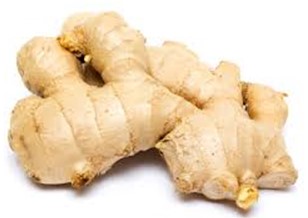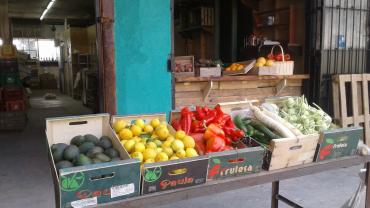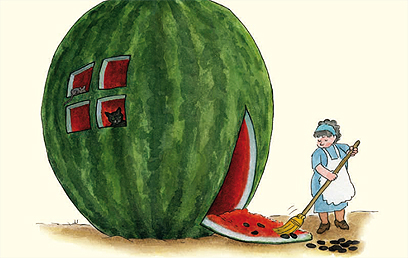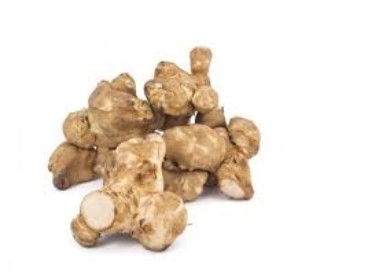If speaking of signs of winter, and root vegetables – let us not skip the ginger!
Ginger is the ultimate warmer. This is not (only) my opinion – the Chinese conceived the idea hundreds of years ago.
If I properly knew Chinese, I would probably discover an ancient Chinese saying that says something like “From the onset of winter, stock up on fresh ginger and preserve your healthy body”. Or maybe something similar, with dragons and spirits.
It is now time for us to start with a deeper acquaintance of ginger and its roots, literally.
Ginger is a perennial plant (although in Israel it is not – I will explain that later) that belongs to the Zingiberaceae family and this is also its true name – Zingiber.
The same botanical family also includes the turmeric and the allspice (both are well-known warming flavors). It originated in China, and spread to the rest of the world: Southeast Asia, India and Africa, and from there it also reached us.
The original name in Latin, zingiber, also originates in these regions, as it is derived from the melody of the word in Sanskrit which means “body with a horn”. It is not known who was the first to dig the curvy plum root from the ground in the jungles of ancient South Asia, but it is known that it managed to reach as far as Greece and Europe even in ancient day.
The Indians in India combined it into their culinary culture, and the Silk Road helped it spread to Central Asia and to the rest of the world – in the form of fresh root, a spice and a powder. Like many other spices we buy casually today, the ginger was traded for gold and precious stones and was placed on the tables of kings and rulers as a special delicacy.
There are dozens of varieties of ginger that differ from each other in the level of spiciness, their texture and their flavor that are grown around the world – mainly in China, India and Jamaica, as well as in African countries.
It is also grown in Israel (interestingly, ginger is known only as a cultivated plant and wild ginger plants were not reported, not even in its area of origin) – in order to reduce the exposure of ginger to pests in the soil to which it is sensitive, some growers In Israel, use a detached substrate. The ginger is planted in the spring, and then removed from the ground after 9 months, around November, to see what was obtained.
However, in China it is customary to leave a small piece of a tuber in the ground for it to grow into a new root for next season, in Israel the entire tuber is removed because the local winter is too cold for the ginger.
The local crop of ginger allows for a taste of the fresh root. How can we tell the difference? Fresh ginger looks like a “live” root – it has some sprouts and roots on it, compared to the imported ginger that undergoes some pest control process, and waits on the shelf and in the warehouse.
The peel of the fresh ginger is bright, taut, thin brown (and if it is really fresh ginger it can be even pinkish) and the root itself maintains a high fluid tone.
If you hold such a root in your hand it will look full of juice, and any little piercing of the skin will release a maddening and refreshing smell. In contrast, ginger that is not fresh looks slightly dried, with a thicker skin, and full of fiber on the inside (the fresh root has fewer and thinner fibers).
The ginger is well known in folk medicine in Eastern countries as a good remedy for many ailments(but not only): relief of pain and inflammation, a remedy that helps against nausea (both during pregnancy and as a remedy for seasickness or carsickness). It is considered to improve blood circulation, balance cholesterol levels, and balances blood pressure, prevents the development of cancer cells and is also considered an aphrodisiac and enhances male stamina.
In ancient Greece it was attributed with the properties of helping to improve kidney function, in India it is used to treat indigestion ailments and stomach cramps, and in Europe it was used to cure colds. In the kitchen it is most common in winter soups, especially those based on coconut cream and orange vegetables, as well as in desserts (ginger cookies!).
And if you too feel like trying to include some ginger in your diet, the simplest way is to add a slice to a glass of hot water with some lemon and honey.
Yours.
The Garden’s team
Forecast:
In the ORGANIC vegetable baskets we expect (draft only):
Cucumber
Tomato
Lettuce
Potato
Carrot
Eggplant
Swiss Chard
Sweet potatoe
Parsley
The Large organic vegetable baskets also include:
Sweet potatoe
Spinach
Coriander
In the ORGANIC fruit baskets (NEW – Increased variety, price – 70 Shekels)
Oranges
Grapefruit
Banana
Clementine
Pomelo
The large ORGANIC fruit baskets also include: ( NEW – Increased variety, price -100 Shekels)
Lemon
Papaya
Sweetie
The ORGANIC Green Basket:
Swiis Chard
A kind of lettuce
Kale
Dill
Green onion
Sprouts
Spinach
NEW – The ORGANIC Basket for couples (price – 150 shekels):
Cucumber
Tomato
Lettuce
Potato
Eggplant
Carrot
Cohlrabi
Parsley
Swiss Chard
Beet
Sweet potatoe
Coriander
Pepper
Oranges
Clementine
Sweetie












